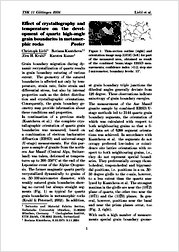Effect of crystallography and temperature on the development of quartz high-angle grain boundaries in metamorphic rocks
2006Universitätsverlag Göttingen
Sammelband- / Konferenzbeitrag
Verlagsversion
Deutsch
Liebl, Christoph; Kuntcheva, Boriana; Kruhl, Jörn H.; Kunze, Karsten, 2006: Effect of crystallography and temperature on the development of quartz high-angle grain boundaries in metamorphic rocks. In: Philipp, S.; Leiss, B; Vollbrecht, A.; Tanner, D.; Gudmundsson, A. (eds): 11. Symposium "Tektonik, Struktur- und Kristallingeologie"; 2006, Univ.-Verl. Göttingen, p. 132-134., , DOI: 10.23689/fidgeo-1878.
 |
Dokument öffnen: |
Grain boundary migration during dynamic
recrystallization of quartz results
in grain boundary suturing of various
extent. The geometry of the sutured
boundaries is affected not only by temperature,
strain rate, finite strain and
differential stress, but also by internal
properties such as the defect distribution
and crystallographic orientations.
Consequently, the grain boundary geometry
may provide information about
these conditions and properties.
In continuation of a previous study
(Kuntcheva et al.) the complete crystallographic
orientation of quartz grain
boundaries was measured, based on
a combination of electron backscatter
diffraction (EBSD) and universal-stage
(U-stage) measurements. For this purpose
a sample of granite from the northern
Aar Massif (Central Alps, Switzerland)
was taken, deformed at temperatures
up to 300–350°C at the end of the
Lepontine event of the Alpine Orogenesis...

